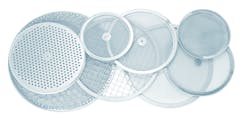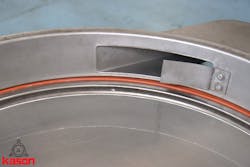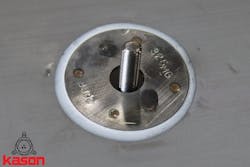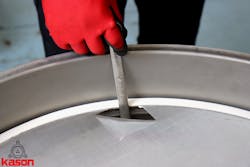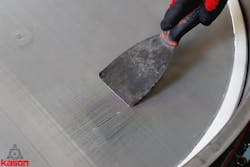Circular vibratory screeners: Five main causes of screen failure
Circular vibratory screeners are widely used for sifting, separating and classifying chemicals, pharmaceuticals, foods, minerals and other powders and granules. A typical circular vibratory screener consists of one or more horizontal screens mounted in round frames with ring clamps. In screeners with more than one screen, the screens are stacked so that the screen with the largest mesh opening is at the top and the screen with the smallest mesh opening is at the bottom. A post through each screen’s center fits into a welded bushing and consists of a threaded bolt with a washer and nut; the washer and nut are tightened over the center post to tension the screen. A material discharge is typically located at one side of each screen.
In operation, the material to be screened is fed into the screener’s top as an eccentric-weight drive mechanism applies horizontal and vertical vibratory motion to the screens to promote material flow. On each screen, oversize particles move across the screen surface to its discharge and exit the screener, while on-size particles pass through the screen.
Screens on circular vibratory screeners can fail for a number of reasons, but the five most common are screen fatigue, improper installation, corrosion, shock and abrasion. Understanding these common causes of screen failure will enable users to avoid costly downtime by proactively inspecting, maintaining and replacing screens before they fail.
1. Screen fatigue
Approximately 90% of screen failures Kason has seen over decades of experience were caused by screen fatigue. Screen fatigue can occur for several reasons, but all are ultimately linked to the rapid and repeated flexing of the screen mesh.
The best visual indication of screen fatigue prior to failure is a floppy screen. When examining a screen post-failure, look for rounded wire ends with a dark color, which is characteristic of a screen that was damaged because of fatigue.
The best defense against screen failure due to fatigue is a properly tensioned screen, so correct screen installation is critical. Be sure to tighten the screen ring clamps. Loose clamp rings can cause screen rotation, which results in the screen losing tension, flexing during vibration and ultimately failing. If you find that standard clamp rings are cumbersome or if you need to carry out frequent screen changes, quick-disconnect models are available.
Be sure to draw tension to the center post. This is especially important for fine mesh screens. Screens must be properly tensioned to function correctly.
Fatigue-based screen breakage can also stem from wear caused by anti-blinding devices. The plastic rings that are commonly used to prevent blinding can experience jamming during the screener’s continuous multi-plane inertial vibration. This can cause the mesh face of the screen to repeatedly vibrate over the ring until flexing leads to breakage. To spot this type of failure, look for a circular imprint on the underside of the screen.
A rubber wiper mechanism is another device designed to prevent blinding caused by resinous or fatty materials. However, the wipers can also cause screen failure if not properly installed, used and monitored. When properly functioning, the wipers will continually sweep across the top of the screen to maximize throughput. When installed incorrectly, the wipers may jump and bounce on the screen, causing flexing and leading to fatigue and breakage if not caught in time.
Another cause of screen fatigue is the accumulation of material moving around the periphery of the screen. Commonly referred to as rope, these heavy accumulations can constantly pound and wear down the screen until it fails.
2. Improper installation
When installing screens, take the time to ensure that the correct side is facing upwards. When a screen is placed upside down in a Kason VibroScreen unit, for example, there will be a one-inch ridge along the perimeter of the screen, which will prevent material from discharging as intended and cause accumulation on the screen. If not caught in time, the screen will inevitably fail from too much material buildup.
In addition to correctly orienting the screens, ensure that any necessary gaskets are installed on the screens prior to operation. In certain models, failing to install a gasket can result in the screen’s center hole hitting the center threaded rod. Ultimately, this repeated agitation will dislodge the center plate, resulting in damage to the screen.
3. Shock
Shock is another common cause of screen failure. After such a failure, you will generally see rounded wire ends with a distorted surface around the area of impact. Extraneous objects that enter with the material infeed, for example, may result in substantial impact that can separate or tear wires on the face of the screen. Dropping hand tools on a screen during installation can also result in damage. Another common (literal) misstep is accidentally stepping on the screen.
Constant vigilance is key to avoiding shock-based screen failures, but it is also important to prepare for the worst-case scenario by always keeping spare screens on hand. Human error happens, but it doesn’t have to cause costly and lengthy downtime.
4. Corrosion
Most sifters and screeners are built to handle a wide array of materials, including those with corrosive qualities, but even the most heavy-duty screens will need to be replaced eventually. Typically, failure caused by corrosion visually presents itself in wire ends that show a reduced diameter and discoloration. Failure due to corrosion can occur anywhere on the screen but is most common near the edges in applications where material builds up around the screen’s perimeter.
The best way to avoid screen damage from corrosion is to use the appropriate screen material for the product being processed. Also, take the time to routinely inspect screens for signs of wear between use.
5. Abrasion
The final common reason for screen failure is screen damage caused by abrasion. Abrasive materials, high feed velocities, material overload near the center or perimeter of the screen, or even repeated manual scraping or brushing of the screen mesh can all lead to abrasion-related failure. Abrasion is exacerbated when the material being screened is moist or wet, as it will not fluidize in the way a dry material will. Abrasion-related screen failure results in wires near the tear looking polished and shiny with flat ends.
Conclusion
By adhering to proper screen installation, throughput management and routine screen inspections, processors can maximize the longevity of their screens, prevent screen breakage and avoid costly downtime. If a screen does break, determining the root cause will help you avoid repeated failures in the future. Finally, if you can’t determine the reason for your screen failures, a reputable screening equipment supplier typically has experience with a wide range of screening applications and can help identify the cause.
Ryan Long is an integral member of the engineering team working on Advanced Material Processing (AMP) product lines, including Kason and Marion Process Solutions. He is skilled in system design, incorporating all ancillary equipment upstream and downstream of industrial mixers, dryers, sifters and other processing equipment. Long has advanced his career through numerous customer facility visits, extended in-field training and working alongside the engineering team at AMP, parent company of Kason. He holds a degree in mechanical engineering from the University of Iowa.
Kason
About the Author

Ryan Long
Ryan Long is an integral member of the engineering team working on Advanced Material Processing (AMP) product lines, including Kason and Marion Process Solutions. He is skilled in system design, incorporating all ancillary equipment upstream and downstream of industrial mixers, dryers, sifters and other processing equipment. Long has advanced his career through numerous customer facility visits, extended in-field training and working alongside the engineering team at AMP, parent company of Kason. He holds a degree in mechanical engineering from the University of Iowa.
